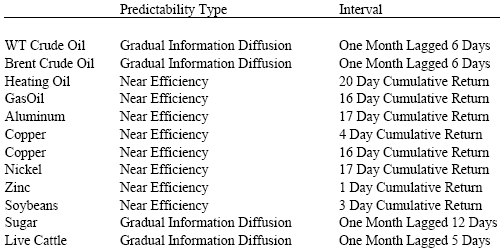Does the predictability of stock market returns depend on exactly when and for how long one measures the predictive variable? In the October 2008 draft of their paper entitled “Return Predictability Revisited”, Ben Jacobsen, Ben Marshall and Nuttawat Visaltanachoti anticipate a substantial fraction of the variation in monthly stock market returns by judiciously refining the observation intervals for a set of predictive variables (prices for the 22 commodities with the largest world production during 2003-2008). The causality chain is, presumably, commodity price changes affect future corporate earnings and/or inflation, and investor expectations about earnings and inflation affect equity valuation. The authors test the predictive power of commodity price changes over a range of measurement intervals under assumptions of both near efficiency (rapid response of equity prices to commodity prices) and gradual information diffusion (delayed response of equity prices). Using daily commodity spot prices as available and monthly stock market returns for the U.S. and 18 other countries since 1970, they conclude that:
- Increases in the prices of crude oil, gasoline, heating oil, aluminum, copper, nickel and sugar in a given month predict, on average, declines in the U.S. equity market the next month. Refining the measurement intervals and immediacy of impact of these predictive variables substantially improves their ability to predict monthly stock market returns, yielding R-squared statistics of up to 18%.
- Industrial metals exhibit near efficient relationships with stocks. In contrast, the effect on stocks of price changes in some energy commodities is delayed, consistent with gradual information diffusion. (See the table below.)
- There is very strong evidence that log changes in the prices of crude oil (gradually diffusing starting after six days), zinc (near efficient for one-day price change) and aluminum (near efficient for 17-day price change) predict stock returns in equity markets around the world.
- This enhanced predictability is statistically and economically significant, and robust to correction for data mining.
- A simple trading rule that uses past movements in crude oil, zinc and aluminum prices to signal investment in either the U.S. equity market or T-bills results, after trading costs, in a Sharpe ratio nearly three times larger than that for a buy-and-hold strategy during 2003-2008. Results for other countries are similar and sometimes much stronger.
The following table, excerpted from the paper, summarizes the measurement intervals and immediacy assumptions with the strongest predictive power for 12 commodities that predict U.S. stock market returns. The most predictive measurement interval ranges from one day to one month. Eight of the commodities apparently affect equity valuations with near efficiency, and four have a delayed effect.

In summary, equity returns may react quickly to some predictors and slowly to others, and they may respond most strongly to short or extended predictor movements. “Standardized” approaches to predictor interval measurement may not work.